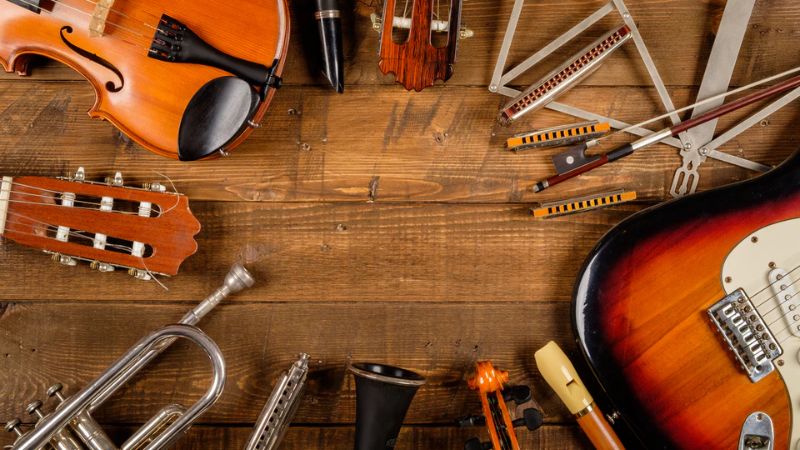Blog
What is the Most Difficult Musical Instrument to Play?
Mastering any musical instrument requires patience, skill, and years of practice. However, some instruments are notoriously more challenging to learn and play due to their technical demands, physical requirements, and need for coordination and precision. So, what is the most difficult musical instrument to play? Join glowcity.xyz explore the complexities of various musical instruments often regarded as the most difficult to master.
Let’s dive into the top contenders for the title of the most difficult musical instrument to play and see what makes each of them so uniquely challenging.
What is the Most Difficult Musical Instrument to Play?
Violin
The violin is widely regarded as one of the hardest instruments to master. Unlike instruments with frets, such as the guitar, the violin lacks markings on the fingerboard, requiring players to learn precise finger placement by feel and memory alone. Producing a consistent tone also demands exceptional bow control and arm positioning.
Challenges:
- Intonation: Without frets or keys, perfect pitch depends entirely on the player’s ear and finger precision.
- Bow control: Players must develop a delicate touch and precise bow movement for smooth sound production.
- Posture and grip: The violin requires an unnatural posture that takes time to master without causing discomfort or injury.
Skill Development: Developing the necessary bowing techniques, such as vibrato and staccato, requires years of practice, and each additional skill builds on the previous foundation, making the violin a lifelong pursuit for perfection.
French Horn
The French horn is notoriously difficult among brass instruments. Its long tubing and narrow mouthpiece require precise control over the lips, or “embouchure”, to produce notes clearly. Small mistakes in pressure or lip positioning can result in “cracking” the note or producing unintended pitches.
Challenges:
- Embouchure control: Players need a refined technique to adjust their lips for each note.
- Breath control: The French horn’s extensive range requires impeccable control over breath support and stamina.
- Hand positioning: Horn players use their right hand inside the bell to modulate sound, a technique that demands experience.
Skill Development: A consistent and clear tone on the French horn often takes years to achieve. Players also develop skills in adjusting the pitch by ear, as the instrument’s responsiveness to slight pressure changes requires sharp, continuous auditory feedback.
Oboe
The oboe produces its sound through a double reed, which requires controlled and precise breath pressure. Even small changes in air speed can dramatically affect pitch and tone quality, so players must develop incredible lung control and stamina.
Challenges:
- Breath control: The oboe demands steady airflow with very controlled pressure to achieve a smooth sound.
- Reed making: Oboe players often craft and fine-tune their reeds, a time-consuming skill in itself.
- Pitch stability: The instrument’s sensitivity to slight changes makes it difficult to play in tune.
Skill Development: Reed-making, unique to oboe players, is both an art and a science that takes years to perfect. Learning to maintain pitch stability under varied conditions adds an extra layer of complexity.
Piano
The piano may appear straightforward, as it has keys that produce clear notes. However, advanced piano playing requires mastery of hand coordination, independence, and musical interpretation. Professional pianists are expected to play complex pieces that demand swift finger movements and an understanding of harmonic structure.
Challenges:
- Hand independence: Pianists often play different rhythms and notes with each hand, which requires precise coordination.
- Finger agility: Complex pieces demand quick finger movements across multiple octaves.
- Expression: Dynamics and phrasing require nuance and control over pressure on each key.
Skill Development: While beginners can produce sound immediately, advanced piano techniques—such as arpeggios, trills, and octave jumps—require years of dedicated practice. Mastering these makes the piano one of the most challenging yet versatile instruments.
Classical Guitar
The classical guitar, with its expressive range and intricate techniques, demands precise finger placement and coordination. Unlike electric guitar, classical guitar relies on fingerpicking, requiring players to develop strength and dexterity in each finger.
Challenges:
- Fingerstyle technique: Players must master fingerpicking for each note, rather than strumming or using a pick.
- Dexterity and precision: Every note must be placed carefully, and even a slight misplacement can affect tone quality.
- Complex compositions: Classical guitar music often includes intricate melodies, harmonies, and rapid shifts in hand positioning.
Skill Development: Classical guitarists spend years perfecting techniques like rasgueado (rapid strumming) and tremolo. As players progress, they must also master the subtleties of dynamics and phrasing to bring out the expressive potential of the instrument.
Harp
The harp is both visually stunning and complex to play. Each string corresponds to a specific pitch, and many harps also have pedals to alter the pitch by a half step. This requires coordination between hands and feet, as well as careful tuning and string control.
Challenges:
- Hand coordination: Both hands pluck different strings simultaneously, often producing melodies and harmonies.
- Pedal control: Players must adjust pedals while playing to change key signatures on the fly.
String control: Each string must be plucked with the right amount of pressure for a consistent tone.
Skill Development: It can take years to synchronize hand and foot movements and to master various plucking techniques and dynamics. Advanced harpists seamlessly shift between complex pieces with speed and grace, a skill that requires intense focus and control.
Bagpipes
Bagpipes are difficult due to their unique mechanics and the physical endurance required to keep a steady airflow. Players must simultaneously control airflow through a bag while fingering notes on the chanter, all while maintaining pitch and volume with drones.
Challenges:
- Breath control: Players must continuously blow air to keep the bag inflated.
- Finger dexterity: The chanter has a unique fingering system that requires agility and precision.
- Coordination: Players need to coordinate breathing, squeezing the bag, and finger movements.
Skill Development: Bagpipes are among the few instruments that require the player to maintain a continuous airflow, which is physically taxing. Skilled pipers develop an exceptional level of breath control and stamina.
Accordion
The accordion requires players to coordinate three actions simultaneously: pressing buttons or keys with the right hand, playing bass notes with the left hand, and pushing and pulling the bellows for air flow. This multitasking is both mentally and physically demanding.
Challenges:
- Bellows control: The bellows must be manipulated to control volume and expression.
- Hand coordination: Each hand plays independently, with one managing melody and the other handling bass.
- Rhythmic complexity: Many traditional pieces are rhythmically complex, adding to the challenge.
Skill Development: Learning to control the bellows and develop hand independence takes years of practice. Advanced accordionists can play intricate pieces that require rhythm, timing, and expression, making it one of the more challenging instruments to learn.
Tabla
The tabla, a traditional Indian percussion instrument, requires intricate finger techniques and coordination. Each hand plays a different drum, each with unique sound capabilities, which demands exceptional rhythmic control and dexterity.
Challenges:
- Finger precision: The tabla relies on specific hand and finger placements to produce distinct sounds.
- Rhythmic complexity: Indian classical music involves intricate rhythms that require years of training to master.
- Coordination: Each hand performs independently, producing different tones and rhythms.
Skill Development: Learning the tabla requires intensive practice of “bols” (rhythmic syllables) and mastery of complex rhythms. It is an instrument that takes years to master and a lifetime to perfect.
Conclusion: Which Instrument is Truly the Most Difficult?
While each of these instruments presents unique challenges, determining the most difficult instrument is subjective and depends on individual skills, musical background, and physical abilities. Instruments like the violin, French horn, and classical guitar often rank among the most challenging due to their high demands on precision, coordination, and endurance.
Ultimately, the most difficult musical instrument is the one that challenges each musician to grow and stretch their abilities. For some, this may be the violin’s intonation, while for others, it could be the bagpipes’ breath control. Each instrument has its own beauty, and the journey to master it is a rewarding experience in dedication and passion.


